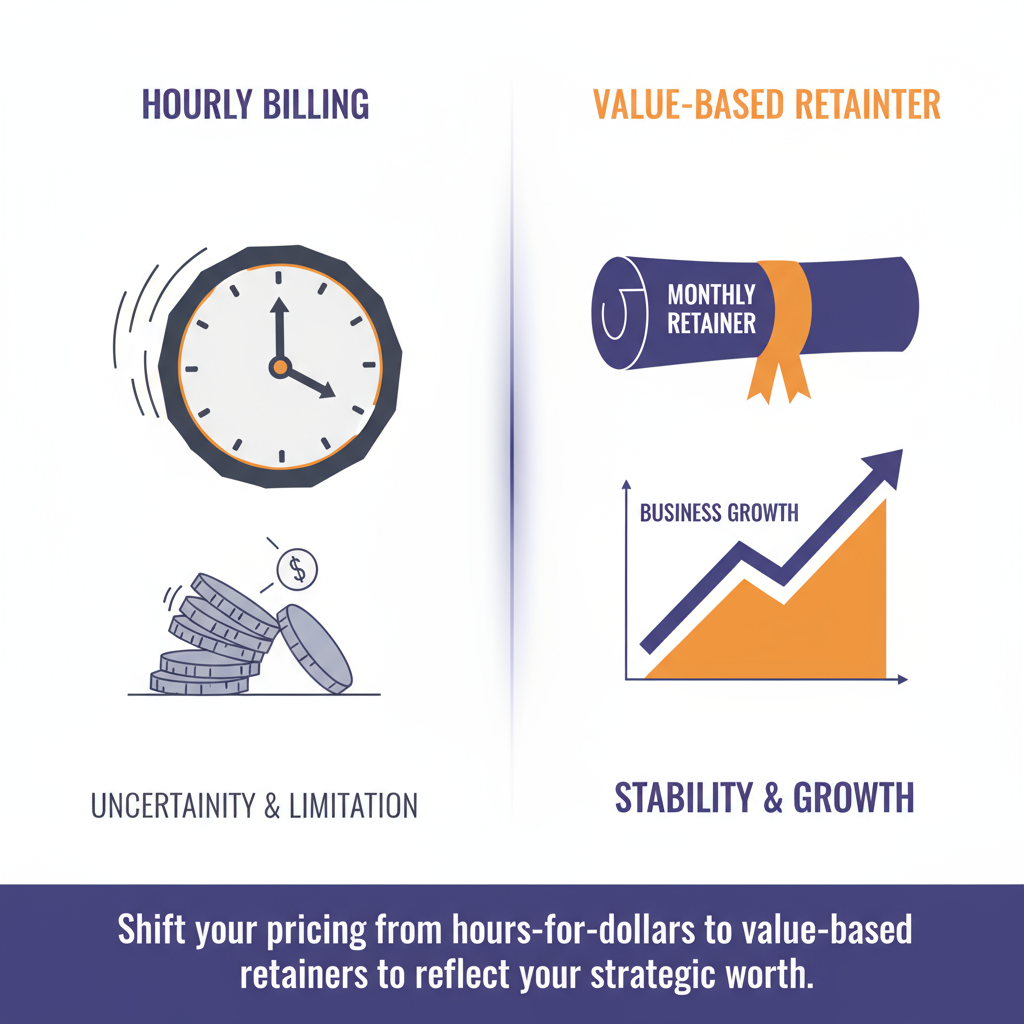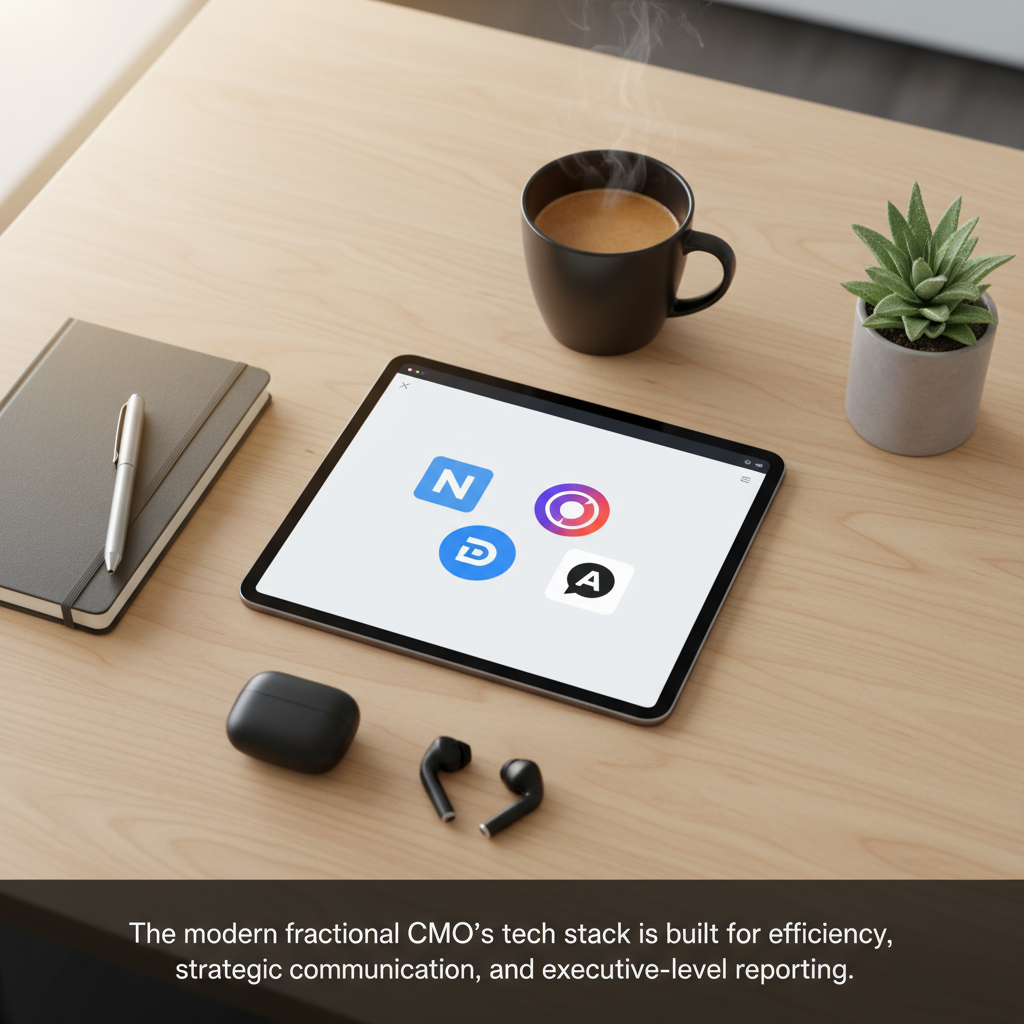Are you an expert marketer stuck in the "hired gun" cycle? You deliver great work, but you're constantly chasing the next project, explaining your value, and hitting an income ceiling that feels unshakable. You know you're capable of more than just executing tasks—you can lead strategy. This is the exact moment where you can make a shift: from a freelance marketer to a fractional CMO. It’s not just a title change; it's a fundamental evolution in your business model that can triple your income and impact.
Key Takeaways
- Shift from Executor to Strategist: A freelance CMO is often hired to *do* a specific task (like run ads), while a fractional CMO is hired to *own* a business outcome (like grow revenue).
- Unlock Higher, Predictable Income: Move from project-based or hourly fees to consistent, high-value monthly retainers that reflect your strategic leadership.
- Integrate as a True Partner: A fractional CMO becomes part of the client's leadership team, influencing decisions and guiding the marketing function from the inside.
- Build a Scalable Business Model: The fractional model allows you to serve a small number of high-quality clients deeply, reducing your time spent on client acquisition and onboarding.
- Attract Better Clients: Repositioning yourself as a fractional CMO signals a higher level of expertise, attracting businesses that need and respect strategic leadership, not just temporary help.

What's the Real Difference? Hint: It's More Than a Title
Let's get this straight. The terms "freelance" and "fractional" are often used interchangeably, but they represent two very different ways of working. Understanding this distinction is the first step to repositioning your value.
The Freelance CMO: The Expert for Hire
As a freelance CMO, you're typically brought in for your specialized skills. A company has a specific marketing gap—they need an ads expert, a content strategist, or someone to manage a campaign launch. You’re hired to fill that gap.
- Scope: Project-based or task-oriented. "We need you to build our email funnels."
- Integration: Operates mostly on the periphery of the business. You get a brief, you execute, you report back.
- Goal: Complete the project successfully, on time, and on budget.
This is valuable work, but it often puts you in a reactive position. You’re a vital resource, but you’re still a vendor.
The Fractional CMO: The Part-Time Strategic Leader
A fractional CMO, on the other hand, is a strategic partner who becomes a part-time member of the executive team. You aren't just executing tasks; you are responsible for the entire marketing strategy, its team, and its results—just on a "fraction" of a full-time basis (e.g., 10-20 hours a week).
- Scope: Outcome-based and strategic. "We need you to build and lead our marketing function to achieve 20% YOY growth."
- Integration: Deeply embedded. You attend leadership meetings, manage team members (or help hire them), and own the marketing budget.
- Goal: Drive long-term business growth through strategic marketing leadership.
Here’s a micro-transformation to consider:
- Before: A client hires you for a $5,000 project to "overhaul their SEO." The engagement ends after two months.
- After: A client retains you for $8,000/month to "own their organic growth channel." You manage content, SEO, and link-building as a cohesive strategy tied directly to lead generation. The engagement lasts 12+ months.
The Evolution Framework: How to Go from Freelancer to Fractional CMO
This transition doesn't happen overnight. It requires a deliberate shift in how you position yourself, package your services, and build your brand. We'll break it down into three actionable phases.
Phase 1: Audit Your Mindset and Positioning
First, you have to change how you see yourself and how you talk about your work. Stop selling activities; start selling outcomes.
- Score Your Language: Review your website, LinkedIn profile, and proposals. Are you listing services like "PPC Management" and "Content Creation"? Or are you promising outcomes like "Scalable Customer Acquisition" and "Revenue-Driven Content Strategy"?
- Identify Your Ideal Client Profile: Fractional CMOs work best with companies that are big enough to need strategic leadership but not ready for a full-time, $250k+ executive. Think Series A startups or businesses in the $5M-$50M revenue range. Use AI tools like Perplexity to research companies that have recently received funding but don't list a CMO on their leadership team.
- Reframe Your Case Studies: Don't just show what you did; show the business impact. Connect your marketing work directly to revenue, user growth, or market share.
Phase 2: Repackage and Price Your Services
Your pricing model is a critical signal of your value. Hourly rates are the enemy of strategic positioning. You need to move to a value-based retainer model.
- Define Your Core Offering: Create a standardized fractional CMO package. It's not a list of tasks, but a scope of responsibility. For example, it might include: leading weekly strategy sessions, managing the marketing team, overseeing the marketing budget, and reporting to the CEO.
- Calculate Your Retainer: Your price shouldn't be based on hours. It should be based on the value you provide and the cost of the alternative (a full-time CMO). A common starting point for a fractional CMO retainer is between $5,000 and $15,000 per month. If a full-time CMO costs a company $20,000/month with benefits, your $8,000/month retainer for top-tier strategy is an incredible value. For more detailed guidance, check out our post on how to price your freelance services.
- Structure the Agreement: Use 3, 6, or 12-month agreements. This gives you the stability to implement your strategy and demonstrates to the client that you're a long-term partner, not a temporary fix. You can structure your offerings clearly on a dedicated services page.

Phase 3: Build Your Fractional Credibility Hub
To attract fractional clients, you need to look like an executive, not a gig worker. Your online presence must scream "strategic partner." This doesn't mean you need to be a social media influencer. It means you need a central, professional hub that communicates your authority.
A simple, powerful professional page can serve as this hub. It’s your digital HQ where potential clients can see your strategic focus, review your high-impact case studies, and understand your unique value proposition in minutes.
Your transformation in branding looks like this:
- Before: Your online presence is a scattered collection of profiles and a simple portfolio. It shows you're a good executor.
- After: You have a central credibility hub, like a Livesume page, that frames you as a strategic leader with a clear methodology and proven business results. It shows you're a business builder.
Ready to Look Like the Strategic Partner You Are?
Don't let a generic portfolio hold you back. Use Livesume's Professional Page builder to create your own "Fractional CMO" landing page in minutes and start attracting the clients you deserve.
Build Your Executive Presence Now
Your Fractional CMO Tech Stack
Operating as a fractional leader means you need to be efficient and integrated. The right tools are essential for managing your work and communicating your value effectively.
- For Strategy & Reporting: Use tools like Notion or Trello to map out your strategic roadmap and track initiatives. For reporting, connect client data to a dashboard like Databox to provide executive-level visibility on KPIs.
- For Asynchronous Communication: You won't be in the office 40 hours a week, so tools like Loom and Slack are crucial. Use Loom to send video updates and strategy walk-throughs, which is more personal and efficient than a long email.
- For Market Intelligence: Use AI-powered tools like ChatGPT-4 or Perplexity to quickly conduct market analysis, research competitors, and identify strategic opportunities for your clients.

Frequently Asked Questions About Becoming a Fractional CMO
What is the difference between a fractional CMO and a freelance CMO?
The core difference is scope and integration. A freelance CMO is typically hired for a specific project or task (e.g., run a campaign). A fractional CMO is hired as a part-time strategic leader to own the entire marketing function, manage teams, and drive business growth.
How do I price my services as a fractional CMO?
Avoid hourly rates. Price your services using a monthly retainer based on the value you provide. A common range is $5,000 to $15,000+ per month, depending on the company's size, your scope of responsibility, and your experience. This typically represents 30-50% of the cost of a full-time CMO.
What is the average salary of a fractional CMO?
While "salary" isn't the right term, a fractional CMO's annual income can range from $120,000 to over $300,000. For example, serving just two clients at $8,000/month puts your annual revenue at $192,000, often for less than 30 hours of work per week.
What kind of experience do I need?
You generally need 10+ years of marketing experience with a proven track record of success in multiple areas of marketing (e.g., demand generation, brand, product marketing). Experience managing budgets, leading teams, and reporting to executive leadership is critical.
Is a fractional CMO the same as a marketing consultant?
They're similar, but a fractional CMO is more hands-on and integrated. A consultant typically advises and provides a strategy, then leaves the implementation to the internal team. A fractional CMO both develops the strategy and leads its execution.
How do I find fractional CMO clients?
Focus on networking within the startup and private equity communities. Update your online presence to explicitly state you offer "Fractional CMO services." Many clients find fractional executives through referrals and by searching for leaders with specific industry experience. Having a strong professional hub makes you discoverable.
What should be in a fractional CMO proposal?
Your proposal should focus on outcomes, not activities. It should include: a clear understanding of the client's business goals, your proposed 90-day strategic roadmap, your scope of responsibilities, the monthly retainer fee, and case studies that prove your ability to deliver results.
Turn Your Expertise Into a Partnership
The demand for experienced, flexible leadership has never been higher. Companies need your strategic brain, not just your hands. By making the deliberate shift from freelancer to fractional CMO, you're not just changing your title—you're upgrading your entire business model.
Here are your first steps:
- Audit your personal brand: Go through your website and profiles right now. Do they scream "executor" or "strategist"?
- Draft your fractional offering: Outline what's included in your retainer. Focus on responsibilities, not tasks.
- Build your credibility hub: Consolidate your expertise, case studies, and strategic approach into a single, professional destination.
Stop applying for gigs and start attracting partnerships. The opportunity to become a strategic leader for multiple exciting companies is right in front of you.